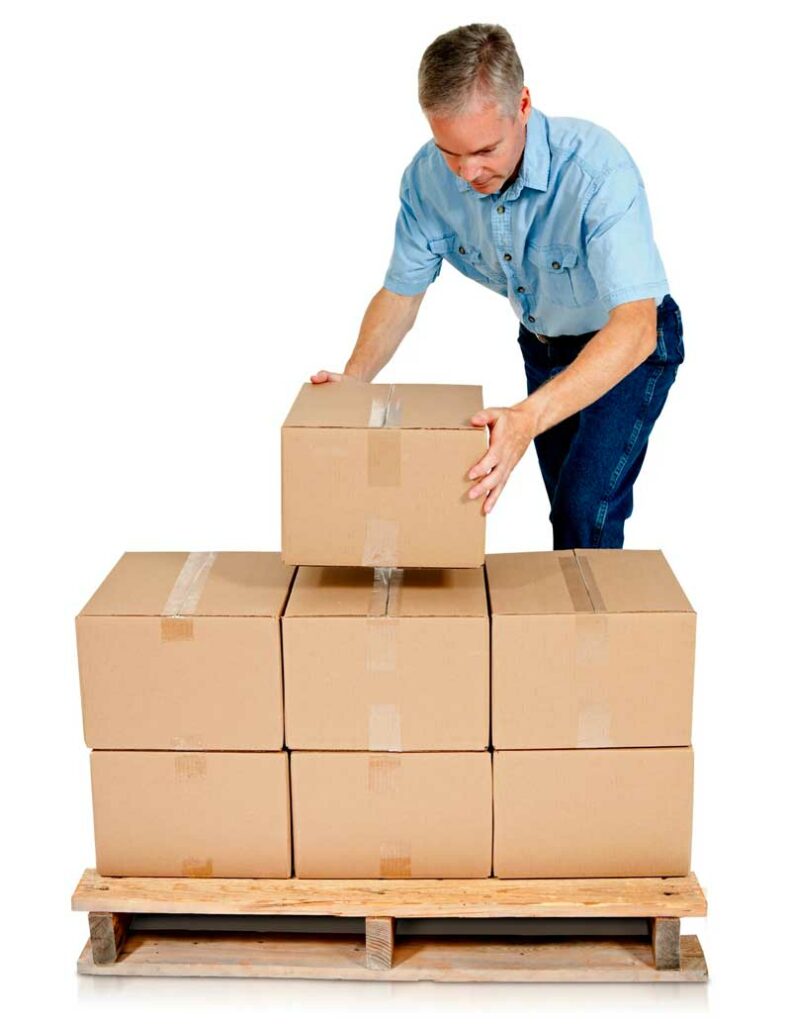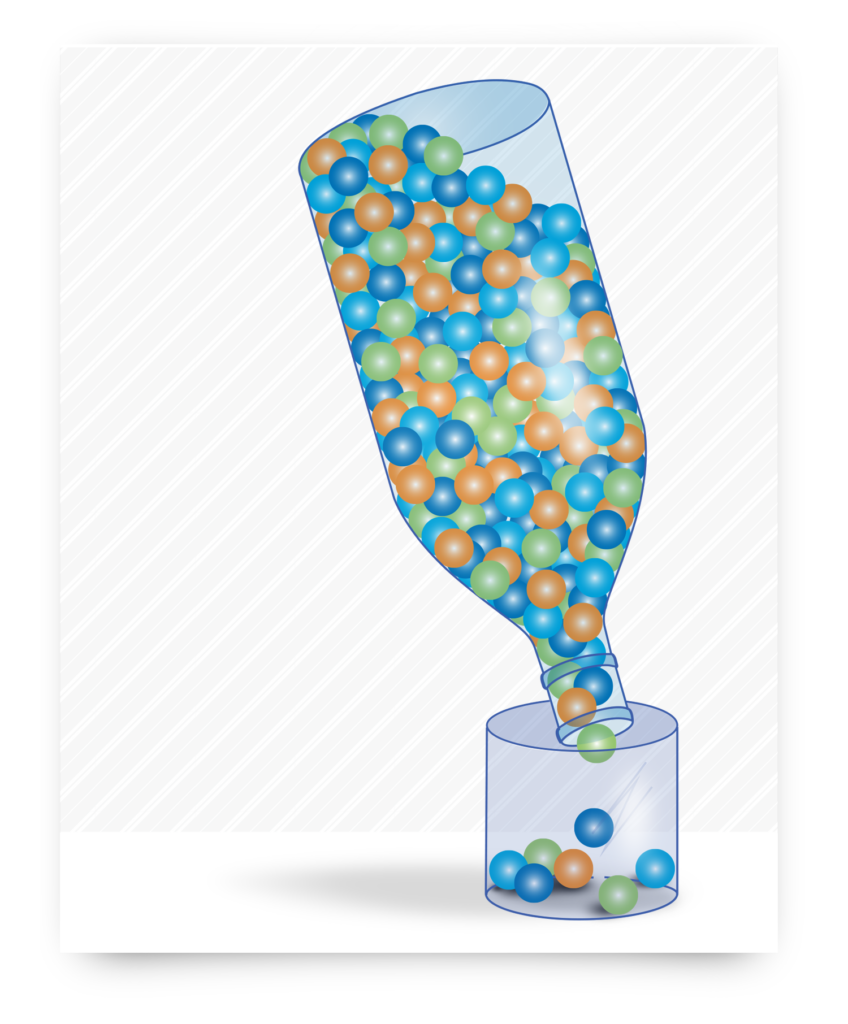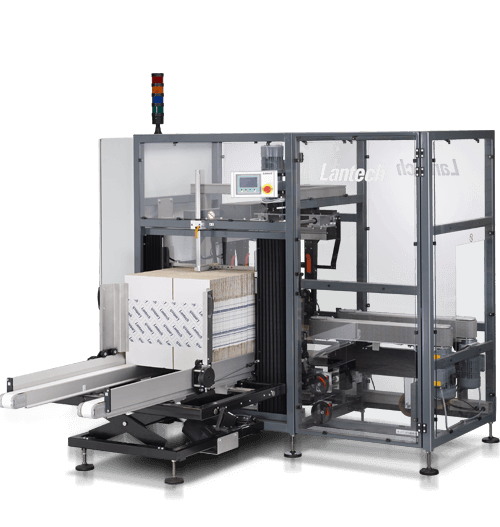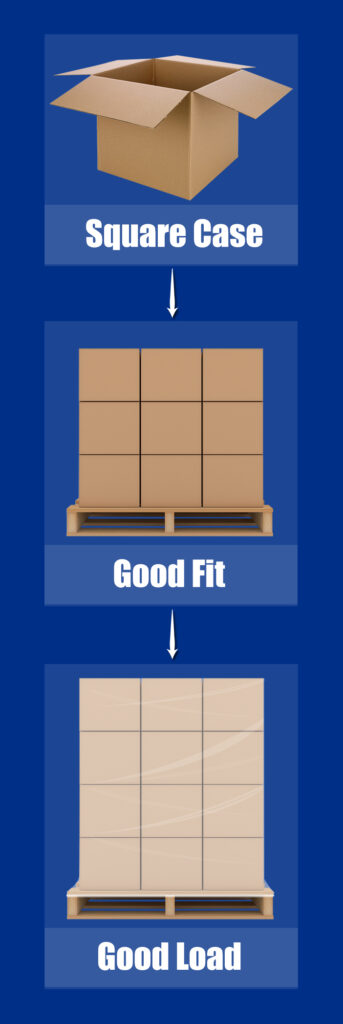Understand the Importance of Case Equipment and How it Can Benefit You
1. Case Packing and Integrating End of Line Packaging Equipment
You’ve done your market research, created a product that your customers love, and implemented world-class production with top-notch quality. Now there is only one thing left to do – pack the boxes and ship the product. What are my options for case erecting, packing, and sealing? Should we just manually build and load the boxes, or should we completely automate the process?
The reality is that case packing, and the integration of end of line packaging equipment, falls on a continuum from fully manual to fully automated. It’s important to know what all of your options are so you can choose the best solutions for your specific situation.
Manual Case Erecting And Packing
Building and packing cases by hand have some obvious benefits that include:
- Requires little training and operators can be up and running quickly
- People can easily adjust for case variations
- Easy to inspect products, load into packaging and adjust as needed
However, there are negatives to manual packing and erecting operations, most notably:
- Ergonomics and repetitive motion injury risk for operators
- May need multiple people to maintain required run rates
Fully Automated Case Erecting, Packing, And Sealing
Fully automating case erecting, case packing and case sealing sounds great in theory. This type of set up is used extensively for high volume, low variation end of line situations. For these applications, automation reduces headcount and increases packaging line output.
If the products and packaging are very consistent and run at high volumes, then full automation may be the answer. Case and product variations, however, can cause problems like jamming and stop production.
Another downside of full automation is that the machines necessary to fully automate need to be purchased and integrated into your existing set up, which is expensive and requires skilled operators to set up, run and maintain the equipment. There is also a time overhead to design, build, integrate, install, test, and debug a fully automated system.
Once up and running full automation also requires maintenance and things like spare parts and downtime for preventive maintenance.
But 100% automation isn’t possible for every situation. Something as simple as putting products in a box can have its challenges, particularly when the products are irregular, complex, or expensive. In these circumstances, conventional pick and place automation often doesn’t work well or can be expensive.
Somewhere In Between
What if case erecting and sealing are automated, consistent, and the packing is done by hand?
A middle ground approach to automation allows the machines and people to do what they do best. The human/machine combination is the best of both worlds in that it incorporates what machines do best – rote work – and what humans do best – make judgments.
People are flexible and when guided by informed judgment, they can deliver adjustments on the fly. An operator can inspect products as they are picking it up, and then insert it properly into a case or remove it from the line for future re-work or inspection. People make adjustments on the fly and deal with a wide variety of situations without causing the line to stop.
A combination of people and automation works for low to moderate volume applications of up to 10 cases per minute.
A few other things to consider when deciding on manual and automated case packing are:
- On average, a medium-sized case can be erected and sealed by hand in 20 seconds per unit. How many cases per minute do you need?
- How big are the products going into the case? If large, or small and delicate, case packing will slow down.
- How many people do you have available to erect, pack and seal cases?
There are potential issues with a mix of manual and automation including the need to maintain the automation, the need for some mechanical infrastructure (like clean, dry air) and carrying spare parts for the equipment.
Manual Vs. Automation: Questions To Ask
- Evaluate the tradeoffs of costs of capital vs. hourly labor.
- Are you running regular daily production?
- Determine the speed tradeoffs of manual vs. automation.
- How many cases per day? (Approximately 500 cases per day are needed for hybrid solution.)
- Do you have few changeovers?
- What is the impact of case quality and reduced defects in packing of goods?
- How many people do you have packing and making cases? (If 4 to 8 operators, consider the hybrid approach.)
- Do the net gains outweigh costs?
There is no one right way to build cases, pack them, and seal them for shipment. Instead, there is a range of options, and a hybrid approach can yield the best return in many situations.
If you would like to talk to one of the experts at Lantech to discuss the right approach for your end of line packaging requirements, please contact us.
2. The No. 1 Thing Most People Don’t Know About Case Erectors
The Law Of Unintended Consequences Is Alive And Well
Erecting cases with a machine will not automatically guarantee an increase in productivity. Without proper planning and consideration, a case erector can cause unanticipated problems and even turn out to be counterproductive. In the worst situations, production is constantly interrupted to recover from unplanned downtime or machine jams.
Why Bottlenecks Happen

There are many environmental factors that affect the performance of corrugate, particularly as it moves through a case erector – temperature, humidity, storage conditions and degree of warp, for example. And, of course, there’s the manufactured quality of the case blanks themselves – dimensional accuracy, depth of score lines, thickness (single wall, double wall), flute size and amount of recycled content. All of these factors affect the ability of the machine to produce a square case and to do it without jamming.
Additionally, relentless cost pressures and sustainability concerns are causing manufacturers to use:
- Thinner corrugate.
- Recycled corrugate.
These new generations of cases increase the ample environmental challenges that case erectors already face and can contribute to excessive machine jams and lost production instead of the intended benefits.
Knowledge, Experience And Anticipation Overcome Problems
But just because something isn’t easy doesn’t mean it’s impossible. Today’s best machines manage to overcome these challenges, make square cases, do so without jamming and deliver the intended productivity gains. Here’s why:
- The designers of these machines have a deep understanding of corrugate – both its strengths and weaknesses. They make machines that anticipate and overcome the environmental variations case blanks are exposed to. They force the case to open so it’s square and then fold and seal it so it’s rigid and the squareness is locked in.
- They manage and control the case through the entire erecting and sealing process. Again, understanding and anticipation are key. Every time a blank or a case moves, there’s the potential for something bad to happen. Effective case management is both an art and a science. Experience and good design, consistently refined, combined with a deep understanding of the corrugated medium virtually eliminate jams.
Preparation Is The Key
Just to be on the safe side, a case erector should have 10 percent more capacity than the primary production line. Don’t forget Murphy’s Law. It says, “If something can go wrong, it will.” And usually at the worst time. No matter where you go around the world, almost everyone has a similar saying.
So be prepared. Build-in enough capacity to recover from unplanned downtime events like:
- Changes to different case sizes
- Tape breaks
- Tape changes
- Power outages
- Upstream or downstream problems
Good planning and sound implementation result in case erectors that are true assets instead of production bottlenecks. Properly deployed, they boost productivity while reducing costs and damage by ensuring that the commonplace corrugated case – that critical tool for supply chain efficiency – delivers its intended value.
3. Why Do Case Erectors Jam?
There’s no simple answer to that question. But basically, they jam because something bad happens during the case erecting cycle. Think of it like this: similar to a butterfly, a case goes through a kind of metamorphous. It starts out as a blank, which is a flat, die-cut piece of corrugated material and emerges from a case erector as a fully formed, bottom sealed case ready for use.
The case erector’s part of this metamorphosis is to take the blank, erect it (form it), and seal the bottom flaps (with either tape or hot melt adhesive) of the emerging case. Properly done, the newly erected case is “square” – all corner angles are 90 degrees – and the case is ready to do the job its designers intended: be easy to pack and stack and provide maximum protection for its contents.
This is a little trickier than it might seem at first glance. Lots of things have to happen in sequence and on time. For example,
- The blank must be loaded into the case erector’s magazine.
- The blank must transfer from the magazine to the forming section.
- The blank must be formed and squared.
- The bottom flaps must be folded.
- The bottom of the case must be sealed.
So anytime a blank moves or makes a transition to another section of the case erector, there’s the potential for that “something bad” thing to happen that might cause the machine to jam.
The best case erectors, though, are designed to manage these transition points and overcome the risks associated with them. Top performing case erectors, for example, use powered infeed belts in their magazines to precisely control the movement of the blanks as they move to the forming section. This overcomes the variability of unpowered, gravity-fed magazines that have little or no control over the blank and consequently are much more likely to jam.
Top product development teams also pay careful attention to the design and operation of the blank separation mechanism to ensure that only one blank at a time is released to the forming section. Poor designs in this critical area are notorious for causing jams.
The actual transfer of the blank to the forming section is a transition that’s also high risk. Not only must the blank separate cleanly from the magazine, but it must also open correctly so the adjacent sides are perpendicular and the opposite sides are parallel. The best case erectors do this by using a “vacuum pick-up frame.”
This device has adjustable vacuum cups that firmly hold two panels of the blank and the frame itself forces the blank to open into a correctly formed square case. Pick-up frames are particularly effective in overcoming minor manufacturing variations in blanks – they force the blank to open correctly. This is another example of how proper attention to and management of critical transition points reduce the potential for jams to happen.
Once the case is square, that “squareness” needs to be locked-in by folding its bottom flaps. Trying to do this while the case is moving is hard and often results in a jam. It’s best to use a machine that folds the bottom flaps while the case is stationary. This is another example of how maintaining control of the case can reduce the potential for jams and how a square case is delivered to the sealing section – another critical transition point.
Sealing sections consist of a pair of belts that hold the case’s long sides (its length) and convey it over a tape dispenser or a hot melt glue nozzle that seal its bottom flaps. Minor differences in case widths caused by manufacturing variations in the blanks can result in jams.
If the case is too wide or too narrow when it reaches the side belts, a jam is likely unless precautions are taken. The better machines deal with these issues by “spring loading” the side belts so they can move closer together or farther apart to deal with either condition, yet still hold the case securely enough to move through the section and be effectively sealed.
A Brief Note About Case Quality
There are a host of issues surrounding corrugated case quality. But for the purpose of this conversation, it’s worth noting that there’s a trend today toward using thinner board and more recycled content.
These cases challenge the capabilities of many case erectors and, in many instances, result in unacceptable and unnecessary levels of downtime. In today’s environment, the quality of the case erector is more important than ever in helping companies achieve their cost reduction and sustainability goals.
Any reputable case erector manufacturer will be happy to test your cases on their machines and work with you to ensure the benefits of your case erector are fully realized.
4. Three Ways Case Erectors Reduce Shipping Damage

The easiest and most cost-effective way to create square cases is to do it with a case erecting machine. Case erectors pull blanks from a magazine, square the box and tape the bottom flaps to form 90-degree angles on all sides.
Just like knowing the fundamentals of a sport is essential to becoming a great player, creating a square case is fundamental to preparing products for successful shipment. Here’s why:
- Square cases are easier to pack.
Whether you’re using an automated case packer or packing cases by hand, it’s easier to do when the case is square. It’s important to pack products securely so the primary packaging is less likely to be damaged during shipment.
- Pallets built with square cases stack better.
When the corners of a case are aligned properly, they’ll support more weight. If they’re not square, the cases are unstable and more prone to being crushed. In fact, when cases are stacked on a pallet and the sides aren’t aligned, the load loses 30 percent of its stacking strength, making it more susceptible to damage.
- Square cases protect your products better.
When cases are square, they stack better on a pallet – which makes them easier to effectively stretch wrap. Loads go through a lot of stress during shipment. All the starting and stopping, vibrations and bumps will take a toll. Square cases make loads that fit better inside the perimeter of a pallet. Boxes that hang over the sides of the pallet can be damaged by a fork lift or crushed against another load or truck wall.
Building square cases by hand isn’t as easy as you might think. It can be difficult to tape box after box perfectly. If you’re spending money on corrugate you want to make sure it’s doing the job you intended it to do. A good case erector can provide the consistency manually erecting lacks.
5. How Can You Benefit from A Case Erector?
If you’ve been considering a case erector for your production line, here are five benefits a case erector can offer your company.
- Increases productivity
The average worker erects three boxes every minute. A basic case erector can produce 10 boxes per minute. That’s a productivity increase of 233%. Faster machines increase productivity even more.
To make 2,500 cases, it takes almost 14 hours of time to erect them by hand. With a case erector, your time is reduced to only four hours. What could you do with ten extra hours?
- Reduces operational costs
Similarly, if you find you’re adding workers to the packing area because they can’t all keep up, you may discover that by having boxes being made quickly and easily, your packers work much more efficiently. That means you can reduce overtime, or reassign the labor pool, so the extra people can work elsewhere.
- Reduce repetitive strain and the possibility of injury
Anyone who performs the same task over and over again knows the pain of repetitive strain injury. Also, multiple cuts and lacerations can result from contact with the edges of the cardboard or exposure to the blade in a hand-held tape dispenser. Using a case erector greatly reduces the risk of workers injuring themselves, or suffering repetitive strain injury.
- Reduces inventory
If you’ve ever had your workers erect dozens or even hundreds of boxes in anticipation of a large shipment, you know the headaches of trying to find space for all of those empty boxes. You’re basically paying to store a whole lot of empty! Each box takes up valuable floor space if you have to regularly pre-assemble boxes just to keep up with a large product flow.
Since you know that pre-ordering raw materials or pre-erected finished products wastes space, you’ll understand how pre-erecting boxes does the same thing.
- Reduces shipping damages
In a previous blog post on case erectors, we talked about how hand erecting cases can often lead to unsquared boxes, which are weaker when stacked on a pallet. But square boxes can withstand heavier weights, which means they are less prone to shipping damage. Using a case erector can help ensure products arrive intact and undamaged.
The main objections to case erectors are that they jam easily and cause downtime. When erecting a high number of cases daily in a production line, this can be a major frustration. There are four primary reasons case erectors jam:
- Blanks are not fed correctly into the magazine.
- Irregularities in the blank from the carton supplier.
- The mechanical forces of opening the case and folding the flaps.
- Transporting the formed case through the machine.
Find out how to can overcome these problems and what to look for in a case erector that will not only erect perfectly square cases, but will also not jam.
A case erector might seem like an unnecessary extravagance. But when you look at the extra cost and time lost in unproductive work, overtime and injury, you begin to see the benefit a case erector can bring to your company.
